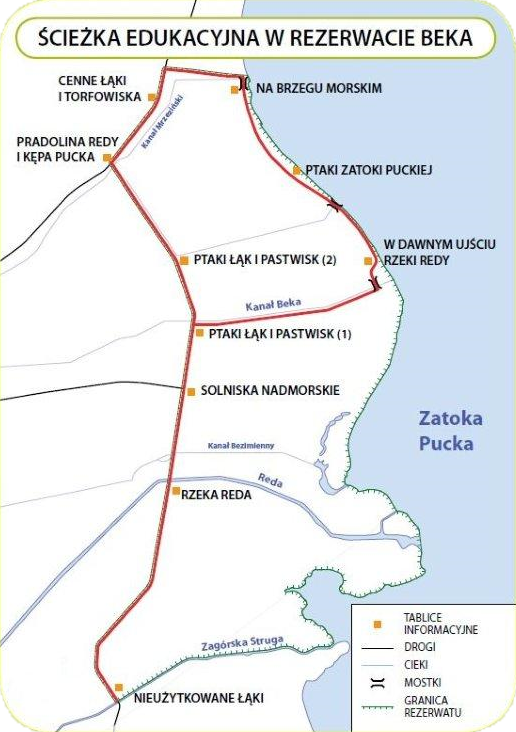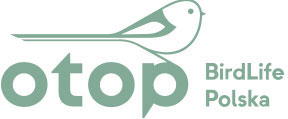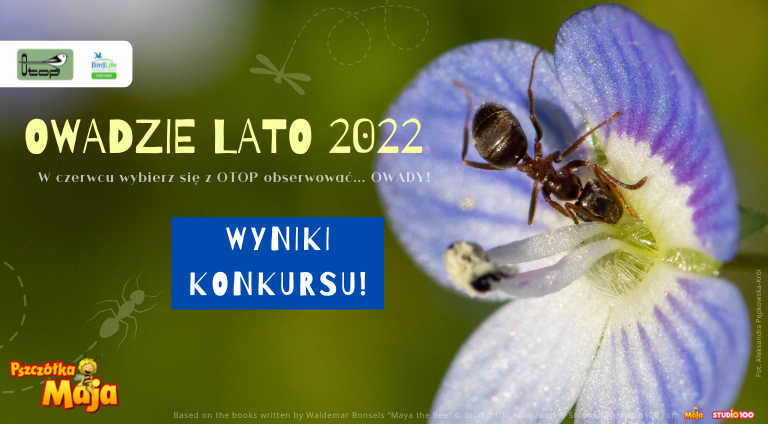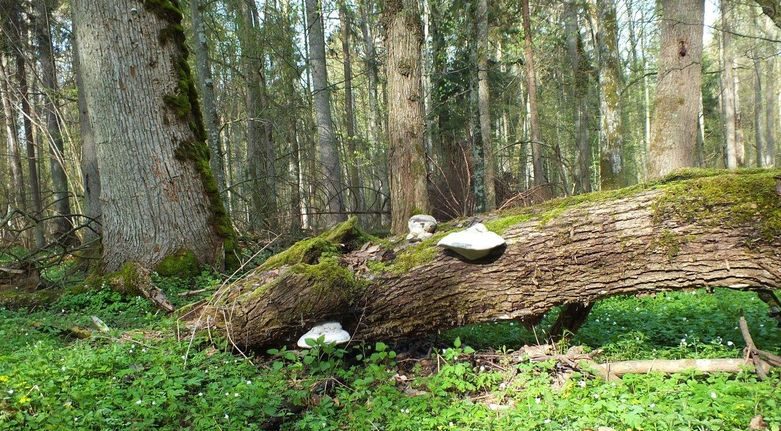Explore a place by the Pucka Bay, where in spring and summer - instead of a crowd of tourists - you will enjoy peace and bird chorus. Leave your car at home, mount your bike and come to see one of the last such spots in our coast.
 The Beka nature reserve was established with the resolution of the Minister of Environmental Protection and Natural Resources of November 17, 1988. The reserve includes the section of the low coast of the Pucka Bay within the Nadmorski Landscape Park. The main conservation goals in this area is to maintain, for scientific and didactic reasons, wet salty meadows (halophyte communities), rare communities of sedge flush mires and rich breeding and migratory avifauna. The Beka reserve was incorporated into the Natura 2000. It is listed as a protected area based on the Birds Directive - a special protection area (PLB 220005 Zatoka Pucka) and the Habitat Directive - a special area of conservation (PLH 220032 Zatoka Pucka i Półwysep Helski).
The Beka nature reserve was established with the resolution of the Minister of Environmental Protection and Natural Resources of November 17, 1988. The reserve includes the section of the low coast of the Pucka Bay within the Nadmorski Landscape Park. The main conservation goals in this area is to maintain, for scientific and didactic reasons, wet salty meadows (halophyte communities), rare communities of sedge flush mires and rich breeding and migratory avifauna. The Beka reserve was incorporated into the Natura 2000. It is listed as a protected area based on the Birds Directive - a special protection area (PLB 220005 Zatoka Pucka) and the Habitat Directive - a special area of conservation (PLH 220032 Zatoka Pucka i Półwysep Helski).
Management by PHRiN, cattle pasturage, corresponded to the former ways of farming and as a result the brackish meadows were maintained in good condition. By the end of the 1970s, up to 150 cows were kept in the area of the today's reserve. At the same time, the area was noticed and acknowledged for its natural features and attempts were made to introduce legal protection.
Consequently, by the end of the 1980s, the Beka reserve was established. Introduction of strict protection and a ban on farming in Beka coincided with the closing down of PHRiN in Celbowo. Lack of farming in Beka was detrimental for the site and led to disappearance of the unique halophyte habitats, which where the very reason for creating the reserve. It was 'forgotten' that the salty meadows were semi-natural habitat, i.e. one that needs suitable human management to be maintained. For this reason, since 1999 the Polish Society for the Protection of Birds has been carrying out active conservation measures, such as pasturage and mowing, which allow elimination of reeds. Thanks to our actions a large area of saline meadows have been restored to a similar condition as when they were grazed in the 1970s.
When and why was the reserve created?
 The Beka nature reserve was established with the resolution of the Minister of Environmental Protection and Natural Resources of November 17, 1988. The reserve includes the section of the low coast of the Pucka Bay within the Nadmorski Landscape Park. The main conservation goals in this area is to maintain, for scientific and didactic reasons, wet salty meadows (halophyte communities), rare communities of sedge flush mires and rich breeding and migratory avifauna. The Beka reserve was incorporated into the Natura 2000. It is listed as a protected area based on the Birds Directive - a special protection area (PLB 220005 Zatoka Pucka) and the Habitat Directive - a special area of conservation (PLH 220032 Zatoka Pucka i Półwysep Helski).
The Beka nature reserve was established with the resolution of the Minister of Environmental Protection and Natural Resources of November 17, 1988. The reserve includes the section of the low coast of the Pucka Bay within the Nadmorski Landscape Park. The main conservation goals in this area is to maintain, for scientific and didactic reasons, wet salty meadows (halophyte communities), rare communities of sedge flush mires and rich breeding and migratory avifauna. The Beka reserve was incorporated into the Natura 2000. It is listed as a protected area based on the Birds Directive - a special protection area (PLB 220005 Zatoka Pucka) and the Habitat Directive - a special area of conservation (PLH 220032 Zatoka Pucka i Półwysep Helski).
Description of land use forms before and after creation of the reserve
The history of coastal meadows that today are in the Beka reserve dates back to 300 years ago. Agricultural use in the area and regular influx of brackish water from the Pucka Bay (every year in the autumn and winter brackish water floods the meadows) drove the development of plant communities - halophytes - that are rare and unique in the Polish coast. They form an excellent breeding site for wetland birds. After World War II, management of Beka was taken over by the Przedsiębiorstwo Hodowli Roślin i Nasion (Plant and Seed Farming Company) in Celbowo.Management by PHRiN, cattle pasturage, corresponded to the former ways of farming and as a result the brackish meadows were maintained in good condition. By the end of the 1970s, up to 150 cows were kept in the area of the today's reserve. At the same time, the area was noticed and acknowledged for its natural features and attempts were made to introduce legal protection.
Consequently, by the end of the 1980s, the Beka reserve was established. Introduction of strict protection and a ban on farming in Beka coincided with the closing down of PHRiN in Celbowo. Lack of farming in Beka was detrimental for the site and led to disappearance of the unique halophyte habitats, which where the very reason for creating the reserve. It was 'forgotten' that the salty meadows were semi-natural habitat, i.e. one that needs suitable human management to be maintained. For this reason, since 1999 the Polish Society for the Protection of Birds has been carrying out active conservation measures, such as pasturage and mowing, which allow elimination of reeds. Thanks to our actions a large area of saline meadows have been restored to a similar condition as when they were grazed in the 1970s.
28 April 2023
OTOP BirdLife Poland kindly invites you to take part in the EU Biogeographical Process Networking Event: Migratory seabirds-friendly management of marine and/or coastal protected areas in […]
2 September 2022
Po ciężkich obradach jury, nastał ten dzień, w którym poznamy laureatów konkursów Owadziego Lata 2022! Do konkursów zaprosiliśmy zespoły szkolne i rodzinne, w których uczestniczące dzieci […]
2 September 2022
Po ciężkich obradach jury, nastał ten dzień, w którym poznamy laureatów konkursów Owadziego Lata 2022! Do konkursów zaprosiliśmy zespoły szkolne i rodzinne, w których uczestniczące dzieci […]
4 October 2017
The last newsletter of BirdLife International brings us to The Białowieża Primeval Forest issue. The Battle for Białowieża is continuing. Jarosław Krogulec, Head of Conservation (OTOP, […]
23 May 2017
BirdLife International releases the publication European birds of conservation concern: populations, trends and national responsibilities. This publication summarises the conservation status of 541 wild bird species […]




